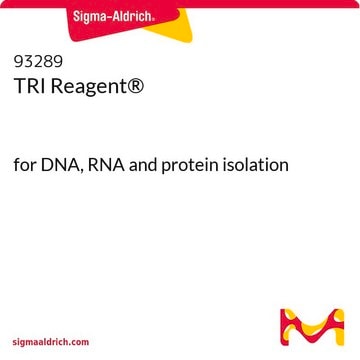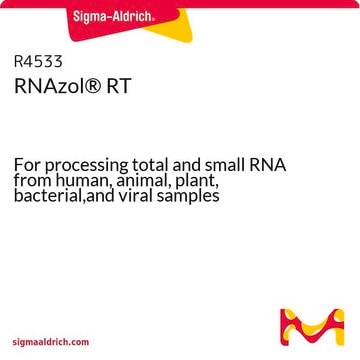T3934
TRI Reagent®
LS, For processing fluid samples such as cell suspensions, CSF, and amniotic fluid.
Synonim(y):
DNA/RNA/protein extraction reagent, DNA/RNA/protein isolation reagent, DNA/RNA/protein purification reagent, cell CSF amniotic fluid RNA extraction reagent, cell CSF amniotic fluid RNA isolation reagent, cell CSF amniotic fluid RNA purification reagent, single step RNA extraction reagent, single step RNA isolation reagent, single step RNA purification reagent, total RNA extraction solution, total RNA isolation solution, total RNA purification solution, TRI Reagent® RNA Isolation Reagent
About This Item
Polecane produkty
zastosowanie
0.75 mL sufficient for 0.25 mL fluid samples
Szukasz podobnych produktów? Odwiedź Przewodnik dotyczący porównywania produktów
Opis ogólny
A convenient single-step liquid phase separation results in the simultaneous isolation of RNA, DNA, and protein. This procedure is an adaptation of the singlestep method reported by Chomczynski and Sacchi for total RNA isolation, and permits fast and efficient processing of liquid samples. TRI Reagent LS performs well with large or small sample volumes, and many samples can be simultaneously extracted.
TRI Reagent LS is a mixture of guanidine thiocyanate and phenol in a monophase solution. When a biological sample is homogenized or lysed with it, and chloroform or 1-bromo-3-chloropropane is added, the mixture separates into 3 phases: an aqueous phase containing RNA, the interphase containing DNA, and an organic phase containing proteins. Each component can then be isolated after separating the phases. 0.75 ml of TRI Reagent LS processes 0.25 ml of a liquid sample such as amniotic fluid.
This is one of the most effective methods for isolating total RNA from fresh samples in only one hour. The procedure is very effective for isolating RNA molecules of all types from 0.1-15 kb in length. The resulting RNA is intact with little or no contaminating DNA and protein.
Zastosowanie
Cechy i korzyści
- Easily scalable RNA isolation
- Works with many sources: human, plant, yeast, bacterial, or viral
- Better yields than traditional guanidine thiocyanate/cesium chloride methods
Informacje prawne
produkt powiązany
Hasło ostrzegawcze
Danger
Zwroty wskazujące rodzaj zagrożenia
Zwroty wskazujące środki ostrożności
Klasyfikacja zagrożeń
Acute Tox. 3 Dermal - Acute Tox. 3 Inhalation - Acute Tox. 3 Oral - Aquatic Chronic 2 - Eye Dam. 1 - Muta. 2 - Skin Corr. 1B - STOT RE 2
Organy docelowe
Nervous system,Kidney,Liver,Skin
Zagrożenia dodatkowe
Kod klasy składowania
6.1A - Combustible acute toxic Cat. 1 and 2 / very toxic hazardous materials
Klasa zagrożenia wodnego (WGK)
WGK 3
Temperatura zapłonu (°F)
174.2 °F - closed cup
Temperatura zapłonu (°C)
79 °C - closed cup
Certyfikaty analizy (CoA)
Poszukaj Certyfikaty analizy (CoA), wpisując numer partii/serii produktów. Numery serii i partii można znaleźć na etykiecie produktu po słowach „seria” lub „partia”.
Masz już ten produkt?
Dokumenty związane z niedawno zakupionymi produktami zostały zamieszczone w Bibliotece dokumentów.
Klienci oglądali również te produkty
Produkty
Proste metody oczyszczania DNA/RNA wspomagają analizę genomu z różnych źródeł, zwiększając efektywność badań.
Simple DNA/RNA purification methods aid genome analysis from various sources, enhancing research efficiency.
Nasz zespół naukowców ma doświadczenie we wszystkich obszarach badań, w tym w naukach przyrodniczych, materiałoznawstwie, syntezie chemicznej, chromatografii, analityce i wielu innych dziedzinach.
Skontaktuj się z zespołem ds. pomocy technicznej














